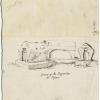‘Mysterious Sepulchres, Podove’
Commentary
Page featuring an engraving (made after a drawing by Arthur Evans), captioned ‘Mysterious Sepulchres, Podove’, published in Arthur J. Evans, Through Bosnia and the Herzegóvina on Foot during the Insurrection, August and September 1875 (London, 1876), p.171.
Artist: Unidentified engraver, after an original drawing [1941.8.172] by Arthur John Evans
Date of publication: 1876
Continent: Europe
Geographical area: Southern Europe
Country: Bosnia and Herzegovina
Region/Place: Podove
Cultural group: European
Format: Woodcut engraving
Page size: 234 x 141 mm
Acquisition: Henry Balfour. Bequeathed February 1939
***
Research notes: It has been identified by Philip Grover that this woodcut engraving by an unnamed artist was based on an original drawing [1941.8.172] by Arthur John Evans, being the depiction of classical tombstones in the village of Podove, near Gučiagora. It was published in Evans’ account of his journey, Through Bosnia and the Herzegóvina on Foot during the Insurrection, August and September 1875 (London, 1876), p.171, printed with the caption ‘Mysterious Sepulchres, Podove’. Evans recorded in the volume: ‘We presently met a party of countrymen, and persuaded one, in return for coin of the realm, to put us into the way to the village of Podove, there to strike the path for the Franciscan monastery of Gučiagora, where we purposed to throw ourselves on monkish hospitality. At Podove we found for the first time some monuments of a kind which we were to meet with again in other parts of Bosnia, and which are scattered over the whole country./ These are large tombstones, some as much as six feet long by three in height, of a tea-caddy shape, resting on a broader stone platform. The impression they give you is that they are descendants of Roman sarcophagi, and indeed their upper part is exactly similar to some Roman monuments. There is, so far as I have seen, no inscription on them: but occasionally, as on some of those at Podove, they are ornamented with incised arches at the end and side of a quasi-Gothic form, which may be useful in determining their date. The erosion of the stone and mutilated condition of many probably point to considerable antiquity, as also does the fact that I have twice noticed them overturned and blocking up the channel of streams which had undermined their original standing ground. They certainly bear no resemblance to the turbaned columns of Turkish cemeteries, and indeed an examination of those at Podove convinced me that many had been purposely mutilated by the unbeliever./ All these facts point to the conclusion that they are, as the Bosniacs express it when they want to indicate a date previous to the Turkish captivity, “more than three hundred years old.” On the other hand, if not Moslem, neither are they like the memorial stone crosses, such as one we were shortly to see at Gučiagora, which are the undoubted work of Christians, and which date back at least to the sixteenth century’: Through Bosnia and the Herzegóvina on Foot, pp.170–172.

